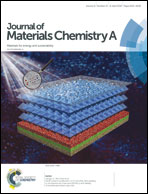Hypercrosslinked mesoporous poly(ionic liquid)s with high ionic density for efficient CO2 capture and conversion into cyclic carbonates†
Abstract
Mesoporous poly(ionic liquid)s (MPILs), featuring a high specific surface area and efficient active sites, are promising candidates for simultaneous CO2 capture and conversion. Herein, a family of sponge-like hypercrosslinked imidazolium-based MPILs with different ionic densities were successfully prepared by free-radical polymerization and subsequent supercritical CO2 drying (SCD). Among these MPILs, PVIm-6-SCD from a monomer which was produced from the reaction of 1-vinyl-1H-imidazole with 1,2,3,4,5,6-hexakis(bromomethyl)benzene and has the highest ionic density (six ion pairs) displayed unprecedentedly high CO2 adsorption: 3.60 mmol g−1 at 273 K and 1 atm. What's more, PVIm-6-SCD, revealed as one of the most efficient catalysts compared to those reported in the literature, can efficiently convert CO2 by cycloaddition with various epoxides into cyclic carbonates at atmospheric pressure, even under relatively low temperature, solvent-free, metal-free and additive-free conditions because of its abundant mesopores providing a large specific surface area and high ionic density providing rich exposed bromide anions as active sites, as well as high CO2 adsorption capacity. Moreover, it can be easily separated with good reusability. This work highlights hypercrosslinked MPILs as a versatile platform to achieve efficient CO2 capture and conversion under mild conditions.



 Please wait while we load your content...
Please wait while we load your content...